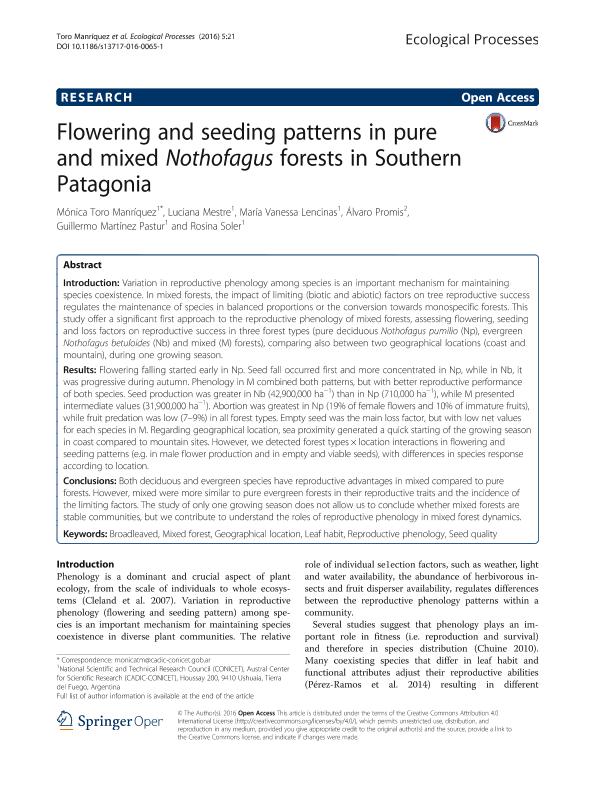Artículo
Flowering and seeding patterns in pure and mixed Nothofagus forests in Southern Patagonia
Toro Manríquez, Mónica del Rosario ; Mestre, Luciana Mariel
; Mestre, Luciana Mariel ; Lencinas, María Vanessa
; Lencinas, María Vanessa ; Promis Baeza, Alvaro Andres; Martínez Pastur, Guillermo José
; Promis Baeza, Alvaro Andres; Martínez Pastur, Guillermo José ; Soler Esteban, Rosina Matilde
; Soler Esteban, Rosina Matilde
 ; Mestre, Luciana Mariel
; Mestre, Luciana Mariel ; Lencinas, María Vanessa
; Lencinas, María Vanessa ; Promis Baeza, Alvaro Andres; Martínez Pastur, Guillermo José
; Promis Baeza, Alvaro Andres; Martínez Pastur, Guillermo José ; Soler Esteban, Rosina Matilde
; Soler Esteban, Rosina Matilde
Fecha de publicación:
12/2016
Editorial:
Springer Verlag Berlín
Revista:
Ecological Processes
ISSN:
2192-1709
Idioma:
Inglés
Tipo de recurso:
Artículo publicado
Clasificación temática:
Resumen
Introduction: Variation in reproductive phenology among species is an important mechanism for maintaining species coexistence. In mixed forests, the impact of limiting (biotic and abiotic) factors on tree reproductive success regulates the maintenance of species in balanced proportions or the conversion towards monospecific forests. This study offer a significant first approach to the reproductive phenology of mixed forests, assessing flowering, seeding and loss factors on reproductive success in three forest types (pure deciduous Nothofagus pumilio (Np), evergreen Nothofagus betuloides (Nb) and mixed (M) forests), comparing also between two geographical locations (coast and mountain), during one growing season. Results: Flowering falling started early in Np. Seed fall occurred first and more concentrated in Np, while in Nb, it was progressive during autumn. Phenology in M combined both patterns, but with better reproductive performance of both species. Seed production was greater in Nb (42,900,000 ha−1) than in Np (710,000 ha−1), while M presented intermediate values (31,900,000 ha−1). Abortion was greatest in Np (19% of female flowers and 10% of immature fruits), while fruit predation was low (7–9%) in all forest types. Empty seed was the main loss factor, but with low net values for each species in M. Regarding geographical location, sea proximity generated a quick starting of the growing season in coast compared to mountain sites. However, we detected forest types × location interactions in flowering and seeding patterns (e.g. in male flower production and in empty and viable seeds), with differences in species response according to location. Conclusions: Both deciduous and evergreen species have reproductive advantages in mixed compared to pure forests. However, mixed were more similar to pure evergreen forests in their reproductive traits and the incidence of the limiting factors. The study of only one growing season does not allow us to conclude whether mixed forests are stable communities, but we contribute to understand the roles of reproductive phenology in mixed forest dynamics.
Archivos asociados
Licencia
Identificadores
Colecciones
Articulos(CADIC)
Articulos de CENTRO AUSTRAL DE INVESTIGACIONES CIENTIFICAS
Articulos de CENTRO AUSTRAL DE INVESTIGACIONES CIENTIFICAS
Citación
Toro Manríquez, Mónica del Rosario; Mestre, Luciana Mariel; Lencinas, María Vanessa; Promis Baeza, Alvaro Andres; Martínez Pastur, Guillermo José; et al.; Flowering and seeding patterns in pure and mixed Nothofagus forests in Southern Patagonia; Springer Verlag Berlín; Ecological Processes; 5; 1; 12-2016; 1-12
Compartir
Altmétricas



